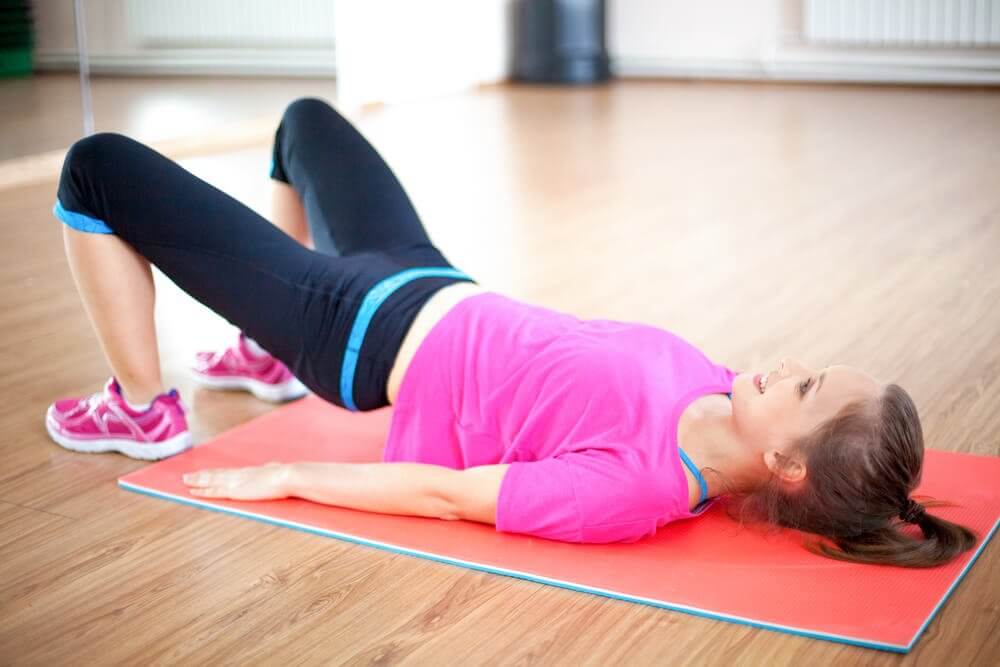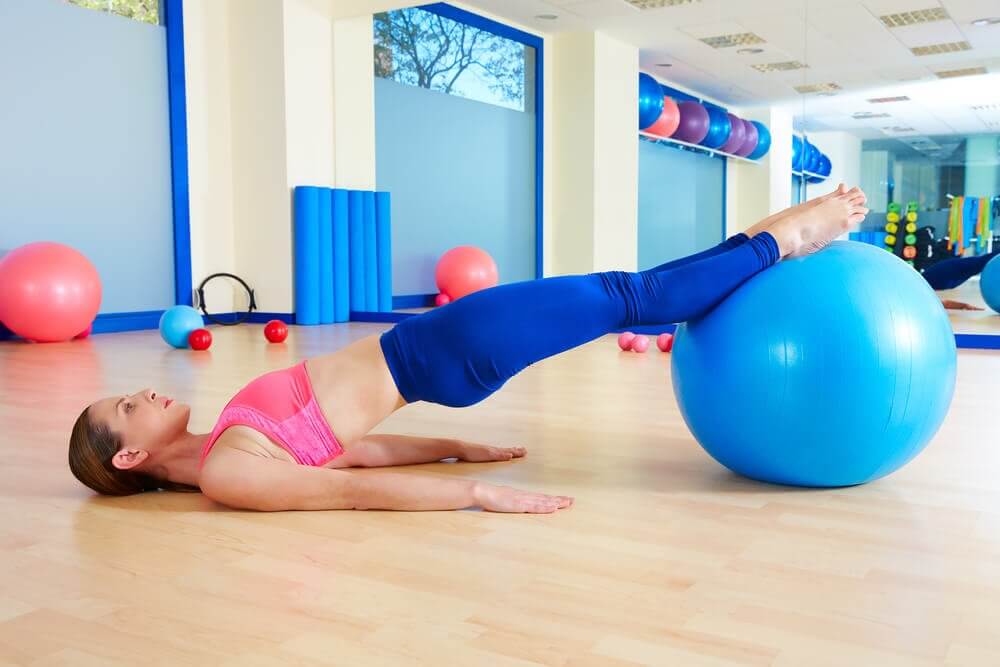Exercising After Delivery: Benefits and Recommendations

Although your body must recover slowly and with precaution, exercising after delivery is also good for you. Let’s take a look at this topic in more detail.
Physical activity is always a good thing for human beings. A sedentary lifestyle has few benefits and can create problems over time. In the case of women in the postpartum period, exercise helps them feel better both physically and emotionally.
It’s important to note that it’s not worth making hasty decisions without consulting with your doctor first. This, far from bringing benefits, can bring you problems. The best thing is to see your doctor and make the decision with him or her about when and how you can begin to exercise.
This is especially important during the first months after delivery.
When to start exercising after delivery
Don’t rush. In general, it’s advisable to wait at least until your quarantine to come to an end. Once this period is over, you can begin to plan a simple exercise routine to the best of your ability. These exercises shouldn’t be high impact or have a long duration.
Little by little, you can increase the physical demand that you place on your body. There is no reason to force the body to perform a championship routine overnight.
It is more important to invest time in doing things well than in rushing and ending up with an injury. You need to take care of yourself for your sake and for your baby’s.

Recovery times vary depending on the type of delivery
If you had a natural delivery, you probably have some muscle distention in the pelvic area. This, on occasion, is responsible for giving women incontinence. Given this, exercise would be counterproductive since it would aggravate the situation.
“Aerobic exercises that include circuits with jumps and abdominal work, among others, are least recommended during the postpartum period.”
If you gave birth via cesarean section, your recovery time lasts a little longer than for a vaginal birth. The scar from this surgery is internal and external, so you should wait a reasonable time before exercising.
It is also important to have your doctor’s approval before doing so. However, every woman is different. There is no rule that brings together each and every case.
Immediate benefits of exercising after delivery
- Postpartum depression is combated by the distraction, the release of toxins and the increase in certain hormones like serotonin.
- Endurance develops over time, which is fundamental for day-to-day activities, especially when taking care of a baby.
- An improvement in sleep quality also occurs. Remember that it’s not about sleeping more, but about sleeping better.
“Exercising after delivery is an excellent option for recovering your figure and improving your mental health, but you should be aware of the most appropriate choices.”
Exercising after delivery: recommended activities
1. Aquagym
This is a low-impact sport that will considerably improve several muscle groups. It consists of doing gymnastics in the water. Thanks to the water, the weight of the body itself is lightened, and this favors postpartum recovery.
The exercises in this discipline work the lumbar and pectoral muscles, as well as the perineum and abdominal area. The water is also very relaxing. This type of exercise provides numerous benefits.
2. Yoga
Thanks to its physical and mental benefits, yoga is great for postpartum recovery. Practicing it helps improve emotional balance and body posture. In addition, you learn to practice deep breathing techniques, which allows you to oxygenate your brain more effectively.
Of course, you must have professional help. This way, you’ll receive instructions about the most appropriate postures for you and how to do them correctly. As in any discipline, you’ll start with smooth and simple movements, increasing the demand as your body tells you it is capable of more.

3. Pilates
This discipline helps tone muscles and, above all, reduces the discomfort of the lower back. In particular, the pelvic and abdominal muscles benefit the most. The perineum also benefits from stretching, which increases in difficulty and intensity over time.
Pilates also offers very good breathing techniques, so you strengthen your muscles while relaxing at the same time. When exercising after delivery, the important thing is to avoid putting too much pressure on your body.
In other words, don’t force yourself to physically push harder than you should just to get an immediate result. Understand and take good care of your body. Give it time.
When you’re ready to exercise after childbirth, consider these options, as they’re ideal for meeting the needs of your body at that time. Remember that the intensity of physical activity should always be mild to moderate during the postpartum period. In addition, the first priority of these routines is to restore strength to the pelvic floor.
Although your body must recover slowly and with precaution, exercising after delivery is also good for you. Let’s take a look at this topic in more detail.
Physical activity is always a good thing for human beings. A sedentary lifestyle has few benefits and can create problems over time. In the case of women in the postpartum period, exercise helps them feel better both physically and emotionally.
It’s important to note that it’s not worth making hasty decisions without consulting with your doctor first. This, far from bringing benefits, can bring you problems. The best thing is to see your doctor and make the decision with him or her about when and how you can begin to exercise.
This is especially important during the first months after delivery.
When to start exercising after delivery
Don’t rush. In general, it’s advisable to wait at least until your quarantine to come to an end. Once this period is over, you can begin to plan a simple exercise routine to the best of your ability. These exercises shouldn’t be high impact or have a long duration.
Little by little, you can increase the physical demand that you place on your body. There is no reason to force the body to perform a championship routine overnight.
It is more important to invest time in doing things well than in rushing and ending up with an injury. You need to take care of yourself for your sake and for your baby’s.

Recovery times vary depending on the type of delivery
If you had a natural delivery, you probably have some muscle distention in the pelvic area. This, on occasion, is responsible for giving women incontinence. Given this, exercise would be counterproductive since it would aggravate the situation.
“Aerobic exercises that include circuits with jumps and abdominal work, among others, are least recommended during the postpartum period.”
If you gave birth via cesarean section, your recovery time lasts a little longer than for a vaginal birth. The scar from this surgery is internal and external, so you should wait a reasonable time before exercising.
It is also important to have your doctor’s approval before doing so. However, every woman is different. There is no rule that brings together each and every case.
Immediate benefits of exercising after delivery
- Postpartum depression is combated by the distraction, the release of toxins and the increase in certain hormones like serotonin.
- Endurance develops over time, which is fundamental for day-to-day activities, especially when taking care of a baby.
- An improvement in sleep quality also occurs. Remember that it’s not about sleeping more, but about sleeping better.
“Exercising after delivery is an excellent option for recovering your figure and improving your mental health, but you should be aware of the most appropriate choices.”
Exercising after delivery: recommended activities
1. Aquagym
This is a low-impact sport that will considerably improve several muscle groups. It consists of doing gymnastics in the water. Thanks to the water, the weight of the body itself is lightened, and this favors postpartum recovery.
The exercises in this discipline work the lumbar and pectoral muscles, as well as the perineum and abdominal area. The water is also very relaxing. This type of exercise provides numerous benefits.
2. Yoga
Thanks to its physical and mental benefits, yoga is great for postpartum recovery. Practicing it helps improve emotional balance and body posture. In addition, you learn to practice deep breathing techniques, which allows you to oxygenate your brain more effectively.
Of course, you must have professional help. This way, you’ll receive instructions about the most appropriate postures for you and how to do them correctly. As in any discipline, you’ll start with smooth and simple movements, increasing the demand as your body tells you it is capable of more.

3. Pilates
This discipline helps tone muscles and, above all, reduces the discomfort of the lower back. In particular, the pelvic and abdominal muscles benefit the most. The perineum also benefits from stretching, which increases in difficulty and intensity over time.
Pilates also offers very good breathing techniques, so you strengthen your muscles while relaxing at the same time. When exercising after delivery, the important thing is to avoid putting too much pressure on your body.
In other words, don’t force yourself to physically push harder than you should just to get an immediate result. Understand and take good care of your body. Give it time.
When you’re ready to exercise after childbirth, consider these options, as they’re ideal for meeting the needs of your body at that time. Remember that the intensity of physical activity should always be mild to moderate during the postpartum period. In addition, the first priority of these routines is to restore strength to the pelvic floor.
This text is provided for informational purposes only and does not replace consultation with a professional. If in doubt, consult your specialist.








